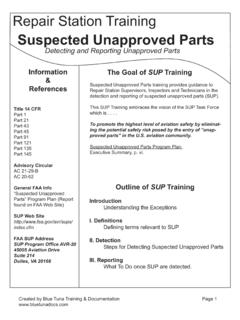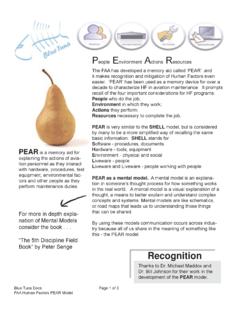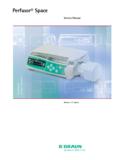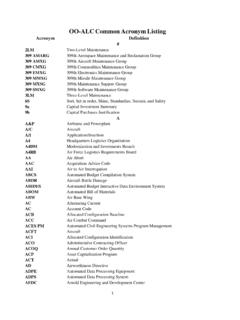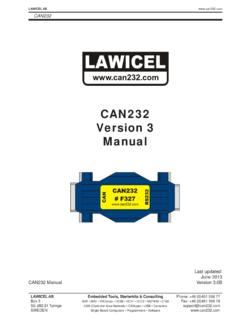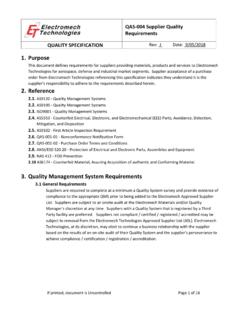Transcription of This (ESD) course will supply instructions to touch, move ...
1 electrostatic discharge . electrostatic discharge (ESD). This electrostatic discharge (ESD) course will supply instructions to touch, move, or use electrostatic discharge sensitive (ESDS) equipment, components safely. The objective of this ESD course is to educate the technician with the knowledge of how to properly handle ESD sensitive Equipment. Upon completion the student will be able to state: What is ESD. How to Identify ESD sensitive equipment How to handle ESD sensitive equipment ESD Prevention The materials required when working on or with ESD sensitive equipment I. We can deal with ESD in two ways: reducing its buildup, and draining it away so it cannot cause any damage. ESD DEFINITION. Definition of electrostatic discharge : This is the name Coulomb gave the Law of force between two charged bodies after his investigation. This investigation was done in 1785. His investigation shown the concept of a charge, one force repulsed, one force attracted.
2 The behavior of a charge body has been observed for centuries. The ancient Greek used amber and fur, they observed when rubbed together, it attracted certain materials, wood, paper ex. Today when the bodies of positive (+) or negative (-) (electric) are at rest - its static RESPONSIBILITY. RESPONSIBILITY. Factors that effect amount of static generated;. Relative humidity Type of material (plastics create greatest static charge.). The responsibility for proper ESD procedures and prevention is in the hands of - EVERYONE! CAUSES OF ESD DAMAGE. CAUSES OF ESD DAMAGE. The Triboelectric charging is a type of contact (friction) electrification in which certain materials become electrically charged after they come into contact with another different material and are then separated (such as through rubbing a balloon against your head). The polarity and strength of the charges produced differ according to the materials, surface roughness, temperature, strain, and other properties.
3 An ESD event occurs when the different static charges between two surfaces become equal. An example of an ESD event is the shock which occurs when you touch a surface after having dragged your feet on a carpet. It is typical for an ESD event to have between 300, to 30,000 volts or more. Some electronic components contain conductors that can melt when an ESD event of less than 100 volts occur. The main cause for ESD is YOU not following and using good ESD work practices. HOW AIRCRAFT discharge . STATIC. HOW AIRCRAFT discharge STATIC. This slide will explain the basics on how a aircraft deals with static electricity. Aircraft use static wicks to displace and remove static charge from the fuselage. As static builds up the static wicks discharge this build up (path of least resistant) at night little lightning bolts can be seen discharging. Note: this is why correct Electrical Bonding is so important!!! The static builds up from the friction of air moving over the fuselage.
4 The antennas and Avionics equipment are grounded to Aircraft structure. TYPES OF DAMAGE. TYPES OF DAMAGE. Failures occur in two forms: Catastrophic - failures occur when a component is damaged to the point where it is Dead On Arrival and it will never function again. Latent This occurs when ESD weakens or damages the component to the point where it will still function properly during testing, but over time the damage components will cause intermittent system performance and eventually complete system failure.,. INSERT DAMAGE VIDEO THIS SLIDE. ESD electrostatic discharge is responsible for damaging many of the rejected avionics electronic components in today's industry. With today's technology components can be damaged by charges of less than 100. volts. Higher technology components can be damaged by charges as low as 25 volts. Damage can not be detected with the naked eye ESD WARNING SYMBOLS. ESD WARNING SYMBOLS.
5 ESD sensitive equipment will have labels identifying it being sensitive to static discharge . NEVER TOUCH THE PINS on the connector or Components on a computer module board. Damage will occur!! Factors that effect amount of static generated;. Relative humidity Type of material (plastics create greatest static charge.). ESD WRIST STRAPS. ESD WRIST STRAPS. ESD wrist straps are for your safety as well as the safety of sensitive equipment ALWAYS wear and plug in the ESD wrist strap while handling ESD sensitive equipment Do not wear the wrist strap inside out, over clothing, or just held in the hand. A simple ESD IC hand lotion can be applied to the skin where the wrist would touch. To prevent accidental shock to personnel working with ESD sensitive equipment the wrist strap equipped with a 1M resister ESD WRIST STRAP CHECKS. ESD WRIST STRAP CHECKS. ESD wrist straps supply a ground between you and the equipment, components and computer modules you touch.
6 Built into the wrist strap is a resister which protects you from too much current flow. Before EACH use of an ESD wrist strap you must check to see if is acceptable for use (at least once a day). To check a wrist strap you can perform one of two tests: 1. You need a test boxes to plug your strap into. The test is simple, go (Green Light) or no-go (Red Light). 2. The second method requires the use of an ohmmeter to measure resistance of the wrist strap. Resistance measurements between 250 K and are acceptable What should you do if your wrist strap fails the daily check, apply lotion and retest ESD CONTAINERS. ESD CONTAINERS. Bags and wraps used to package ESD sensitive items should be Static shielding and must be sealed with approved tape : For temporary or permanent storage of ESDS components, ALWAYS use an approved Faraday cage static shield. Examples of ESD containers are: Covered conductive tote boxes Module ESD metalized bag Clear film ESD bag Seal all bags with anti-static utility tape Use ESD containers when moving ESD equipment, components and computer modules.
7 Static shielding bags or covered conductive tote bins are examples of A Faraday cage. A Faraday cage or Faraday shield is an enclosure formed by conducting material, or by a mesh of such material. Such an enclosure blocks out external static electrical field. Faraday cages are named after physicist Michael Faraday, who invented them in 1836. ESD WORKING ENVIRONMENT. ESD WORKING ENVIRONMENT. Your working environment must be ESD safe for working with ESDS components An ESD approved mat on the working surface must be used along with the wearing of an ESD wrist strap In protecting ESD sensitive devices, bags and wraps are used. When using a protective wrap a static shielding protective wrap with anti-static tape is used In the event your ESD strap fails a regular check apply IC lotion between your skin and strap and retest When handling an ESDS device at a workbench, the individual and workbench must be the same potential Typical electrostatic Voltages Relative Humidity 10-20% 65-90%.
8 Voltages Walking across carpet 35,000 1,500. Walking over vinyl floor 12,000 250. Worker at bench 6,000 100. Vinyl envelope for worker instructions 7,000 600. Common poly bag for parts 20,000 1,200. GENERAL HANDLING. GUIDELINES. GENERAL HANDLING GUIDELINES. Transport ESD sensitive devices to or from an aircraft only in a closed ESD container. Protective materials, covers, and containers should remain in place until the product is to be installed. Handle avionics equipment gently. Do not touch exposed pins, connectors or components. Make sure external connectors are covered with caps. caps help protect LRU from ESD and physical damage. In today's Aircraft computers are the norm, some Have cards or modules that exposes all the components on the card, making proper ESD handling even more Important!!! PROPER HANDLING OF. MODULES. Both images represent the proper handling of modules. PROPER HANDLING OF MODULES.
9 Both images represent the proper handling of avionics computer modules IMPROPER HANDLING OF MODULES. Note the placement of fingers Do not touch any circuitry or pins of a component or module Ensure you are wearing an ESD wrist strap and are grounded RULES TO REMEMBER. When handling or moving components, equipment or computer modules: Do not touch connector pins Handle modules such as computer type modules by the screws and/or handles Be sure to place conductive caps and covers over electrical connectors to prevent inadvertent ESD damage Place ALL ESDS equipment, components and modules in protective ESD. containers Do no place ESDS components or modules on surfaces not having ESD. protective mats or material Transport ESD equipment, components and modules only to areas which provide ESD protection ADDITIONAL INFORMATION: electrostatic discharge Control Handbook Provides guidance for the establishment and implementation of an ESD control program in accordance with MIL-STD-1686.
10 Includes a detailed checklist in Appendix K. MIL-HDBK-263 electrostatic discharge Control Handbook for Protection of Electrical and Electronic Parts, Assemblies and Equipment - Provides additional guidance on the implementation of an ESD control program ESD can be a minor unfelt event measuring a few volts, or a massive event both presenting real dangers to All ESD protections can be used to stop these circumstances, with you now knowing the awareness of what it is and how to prevent it.



